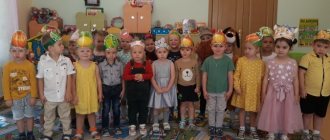MAGAZINE Preschooler.RF
V.G. Belinsky wrote: “Education is a great thing: it decides a person’s fate.” The responsibility that falls on the shoulders of the teacher is not just looking after children and organizing educational games; This is the first step that determines a person's destiny. When a child first attends a preschool, the role of the teacher plays a decisive role. An affectionate, gentle attitude, softness in voice, mystery is one of the possible and repeatedly proven options in a relationship with a child. The teacher, with his entire appearance, must endear the child to himself and positively emotionally set him up for communication. Communication between children can sometimes be unpredictable; intuition and endurance are needed here. The teacher’s speech intonations are of considerable importance. A calm, demanding tone is all you can afford. A teacher who cares only about order and discipline is not a teacher, but a monster. In the hands of the teacher, responsibility is not only for the physical, but also for the moral and psychological state of the child. One of the main tasks of the teacher is to be able to focus children’s attention on the game, interest them and make each child feel that he is an important and necessary member of the team. The teacher must have respect for the child and a highly developed sense of justice. Only with an honest attitude, with the ability to keep his word (the baby always remembers if something was promised to him), periodically letting the children feel, will the teacher achieve maximum success and become an example for the pupils. From the first days, it depends on the teacher what kind of psychological program for the child’s behavior will be laid down. Therefore, game situations should change taking into account the daily routine and time frame. Changing games will create a feeling of a kaleidoscope of unforgettable impressions in the child and will make him want to return to the magical land of kindergarten. The teacher must have a multifaceted talent: instantly fantasize and compose fairy tales based on current situations in order to attract the attention of children. In some moments, you need to rely on your own intuition, which consists of many factors that ensure normalization of the situation in inadequate situations. It is necessary to carefully analyze the individual development of each child. Visibility is the main and decisive factor in the upbringing of preschool children. A child who falls into the hands of a teacher who competently builds his relationship with children, after the first “battles” before visiting kindergarten, soon becomes joyful and cheerful and eagerly goes to kindergarten, where an atmosphere of understanding and goodwill reigns. There are no bad and good children, but there are different temperaments, the characteristics of which the teacher must take into account when choosing methods and means used in kindergarten. If, when working with children, the types of their temperaments are taken into account, then the teacher will practically not have any special problems with the students. Children are always drawn to people who understand what they want without being too strict with them. When children play pranks, they themselves internally expect some kind of reprimand; if it is not forthcoming, then the children try to repeat their prank again. If there was no punishment this time, then we can say with confidence that the children “sat on your head.” In other words, the teacher must be not only gentle and not only strict, but such that the children respect him and at the same time are not afraid of him. A teacher should be such that children see him as an older comrade in games, a caring “mother” in everyday matters, and a loved one who can be trusted with something intimate - every teacher should strive for such an ideal. Unfortunately, educators often make mistakes in raising preschool children: partly due to their inexperience, and partly (although this, of course, should not be allowed) due to an unwillingness to delve into the essence of education. The first mistake is the most serious - the lack of an individual approach to children. Every teacher always needs to remember that each child is unique, individual, that he has a lot of characteristics that distinguish him from other children, many interests that need to be developed. The educator must take full responsibility for the fact that he has in his hands all the possibilities for shaping the child’s character, his worldview, and habits. It is the educator who must pay attention to what activities the child is inclined to and inform the parents about this. If you take a closer look at each child, it will soon become clear that for one it is enough to explain that he is right, for another to set a friend as an example, for the third, try to explain everything on an emotional level (to influence the child’s feelings, and not the teacher’s shouts). In order to correct this mistake, you need to change your views on children in order to identify the differences between a particular child and other children in the group. The second mistake is paying attention to some children at the expense of inattention to other children. Here we are talking mainly about the so-called “favorites”. It should be remembered that children are extremely sensitive - and they usually have a heightened sense of justice. A good teacher should unite children, help them so that each of them finds a friend. The teacher must be equally strict and kind with all children! The next mistake is unfair punishment. The essence of this mistake is that the teacher does not want to understand the children’s actions. At this moment, he is driven by the desire to quickly settle the incident by imposing punishment. Before assigning a punishment (putting him in a chair), you should thoroughly understand the conflict that has arisen and try to judge the parties fairly and, first of all, reconcile the children among themselves. Another type of unfair punishment is the humiliation of a child. Many educators, oddly enough, consider it quite pedagogical to put the guilty child in front of all the other children. Tell them about the offense that he committed, thereby causing laughter and bullying from other children. In this case we are talking about humiliating the dignity of a little person. As a result of such punishment, the child is teased by other children, or even stop communicating with him. The situation can often be resolved only by transferring the other child to another kindergarten. Raising your voice at the child. You can't achieve much by shouting. The child, having become accustomed to having his voice raised at him, subsequently becomes practically insensitive to comments made to him in such a tone. Severity and raising your voice are two different things! It is strictly forbidden to use physical force!!! For each child, you can choose your own key, which will open the way for him to realize his good and bad deeds. If the teacher takes into account all the individual characteristics of each child, then he will learn to find an approach to each child. If you are a teacher in your field, then you will be able to avoid these mistakes and find an approach to each child, his parents and colleagues.| Next > |
Definition, factors and mechanisms of socialization
In any modern society there is a certain set of rules, laws, statutes and other legal and mental acts. In accordance with them, a person is provided with all the conditions for the manifestation and development of his personality. The formation of human personality begins at an early age. The process of a child entering the world of adults has its own characteristics in the early stages of ontogenesis. Changes in the social situation are associated with the need to adapt to new conditions, norms and requirements. A child growing up in modern society enters into completely different relationships and faces a variety of difficulties. Therefore, the main and main task of adults is to help the child acquire some knowledge that he will need in independent life, that is, to acquire some socialization skills.
The problem of socialization in our society has a wide scope. It is important that the child goes through a problematic phase of socialization that begins in early childhood. This means that the child should not feel disadvantaged in communicating with peers. This brings us to the core of the problem described above: how will a child grow up if he is deprived of communication with peers at an early stage of development? Currently, a large number of children who go to school are maladjusted. This may be due to physical or mental health or because they are not ready for school, but there is also a socialization factor to consider.
Within the humanities (sociology, education, social and developmental psychology), there are many formulations and approaches to the study of socialization. In psychology, the study of socialization is usually associated with the study of psychological characteristics, factors and mechanisms of socialization.
Socialization (from Latin socialis - public) is the process of a person acquiring social experience, especially a system of social roles. This process includes the acquisition of social norms, skills, stereotypes, social attitudes, socially accepted forms of behavior and communication, as well as lifestyle choices.
The appearance of the term “socialization” in the humanities is associated with the name of the American sociologist F. G. Giddings. In his book “The Theory of Socialization” in 1887, he defined the essence of this process as the development of the social nature and character of the individual, the preparation of human material for social life. As a generally accepted scientific term, “socialization” began to be actively used in Western philosophical, sociological and psychological literature only in the late 50s of the 20th century. However, there is still no unambiguous interpretation.
In sociological concepts, socialization functions as a process of social adaptation, an individual’s adaptation to the social environment through the assimilation of norms and rules established by society. From the point of view of the interactionist theory, of which J. Mead was a representative, “a person becomes a person only when the reaction of others becomes an integral part of his own behavior.”
In cultural anthropology, socialization is understood as the process of acquiring culture, socially significant values, norms and patterns of human behavior. American ethnopsychologists M. Mead and R. Benedict came to the conclusion that sociocultural factors play a leading role in the mental development of children.
Pedagogy considers socialization as the process of a child’s conscious assimilation of ready-made forms and methods of social life, interaction with material and spiritual culture, adaptation to society and the development of his own social experience. In the works of T. Mora, J. Rousseau, R. Owen, C. Fourier, I.G. Pestalozzi, T. Campanella, A. Disterweg contain provisions on the social nature of education, optimal conditions for interaction between a growing child and society, and a special educational impact on the social environment. At the beginning of the 20th century, the German philosopher and teacher P. Natorp interpreted socialization as free self-education in a community of adults. The researcher considered will as a unique psychological condition for the socialization of an individual. A special approach to the interpretation of socialization can be found in the pedagogical system
M. Montessori. Children's acquisition of social knowledge and skills is not a process of direct teaching, demonstration of adult action patterns and their practice under control. Social knowledge and skills develop naturally in a particular environment.
The most important role in how a person grows up, how his upbringing will take place, is played by the people in direct interaction with whom his life takes place. They are usually called cases of socialization. At different ages, the composition of the product is specific. Thus, in relation to children and adolescents, such agents are parents, brothers and sisters, relatives, peers, neighbors, and teachers. In adolescence or adolescence, agents are also spouses, work colleagues, etc. Agents differ in their role in socialization, depending on how significant they are for a person, how interaction with them is structured, in what direction and by what means they exert their influence.
The socialization of a person in the modern world, having more or less obvious features in one society or another, in each of them has a number of common or similar features. In every society, human socialization at different stages has its own characteristics. The stages of socialization can be correlated with the age periodization of human life. Socialization occurs in the interaction of children, adolescents, and young men with various conditions that more or less actively influence their development. These conditions that affect a person are usually called factors. In fact, not all of them have been identified.
More or less studied conditions or factors of socialization, conditionally combined into four groups, are highlighted by A. Mudrik:
- Megafactors - these include factors such as space, planet, world, which to one degree or another through other groups of factors influence the socialization of all inhabitants of the Earth.
- Macro factors - these include country, ethnic group, society, state, they influence the socialization of everyone who lives in certain countries.
- Meso-factors - these include the conditions of socialization of large groups of people. Mesofactors influence socialization both directly and indirectly through the fourth group of microfactors.
- Microfactors - these include factors that directly affect specific individuals interacting with them - family and home, neighborhood, peer groups, educational organizations, various public, religious, private and counter-social organizations, microsociety.
Socialization not only allows us to communicate with each other through learned social roles. It also ensures the maintenance of society. Although the composition of society constantly changes as people are born and die, socialization helps maintain society itself by instilling in new citizens generally accepted ideals, values, and behaviors.
Socialization of a person in interaction with various factors and agents occurs through a number of, so to speak, “mechanisms.” Agents, along with factors, constitute the mechanisms of socialization.
Socialization mechanisms are divided into two groups:
- Socio-psychological mechanisms;
- Social and educational mechanisms.







